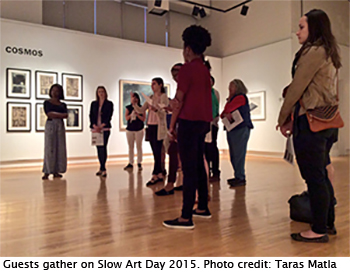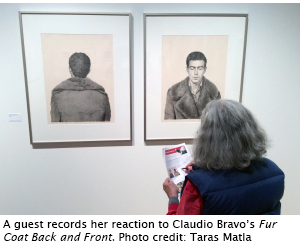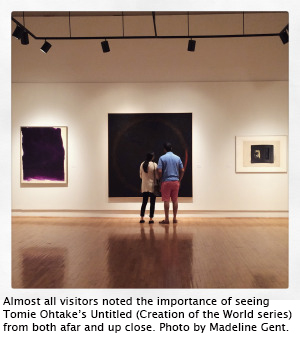Slow Art Day 2015
 Slow Art Day took place on Saturday, April 11 at The Art Gallery, where the exhibition Streams of Being: Selections from the Art Museum of the Americas is on view through April 25, 2015. Seventeen people attended the two-hour event, a number that allowed a very comfortable and intimate discussion to ensue during the second half of the program. The five works highlighted for slow observation were Chilean artist Claudio Bravo’s Fur Coat Back and Front, Cuban artist Mario Carreño’s Sonata de la Piedra y de la Carne, Argentine artist Ernesto Deira’s Tempo, Brazilian artist Tomie Ohtake’s untitled piece from her Creation of the World series, and Chilean artist Roberto Matta’s surrealistic piece Nuit Courve.
Slow Art Day took place on Saturday, April 11 at The Art Gallery, where the exhibition Streams of Being: Selections from the Art Museum of the Americas is on view through April 25, 2015. Seventeen people attended the two-hour event, a number that allowed a very comfortable and intimate discussion to ensue during the second half of the program. The five works highlighted for slow observation were Chilean artist Claudio Bravo’s Fur Coat Back and Front, Cuban artist Mario Carreño’s Sonata de la Piedra y de la Carne, Argentine artist Ernesto Deira’s Tempo, Brazilian artist Tomie Ohtake’s untitled piece from her Creation of the World series, and Chilean artist Roberto Matta’s surrealistic piece Nuit Courve.
The discussion that followed individual viewing brought forth many interesting comments. Some of the participants indicated that while their initial reaction to a particular piece may at first have been negative, their opinion changed after spending ten or more minutes closely examining it. One of the visitors had lived in Chile during the Pinochet era when the lithograph by Claudio Bravo was created. She related her experiences of the country’s political atmosphere at that time to the somber look of the character displayed in the piece.
Reactions to Carreño’s clean and organic piece were, for the most part, positive. The muted colors and the blue drapery helped to soften the otherwise hard edges. One participant, however, described the piece as “bottom-heavy,” while other comments implied that the artist must have – consciously or unconsciously – referenced modern works of art as well as examples from antiquity and the Renaissance.
Viewers expressed a variety of emotional reactions to Deira’s abstract painting, made of industrial enamel on canvas, supplying words like “jarring,” “monster-like,” and “attractive.” One commenter noted that, if turned upside down, the work resembled a silhouette of Mickey Mouse or even of a fawn.
The most common comments about Ohtake’s large canvas were that the muted, fiery color of the circle—hardly discernible from a distance—became visible close up and that the large size of the piece amplified the visual impact that would be lost at a smaller size. One of the attendees played on her phone Johnny Cash’s Ring of Fire, a song that came to mind when she first saw the piece. Comments about Matta’s piece, like those for Deira, were mixed; some people liked it more than others. But the most common comments connected the piece to science fiction themes, from Star Trek to the Twilight Zone, as drawn on a blackboard.
At the end of the event participants said how much they enjoyed it. The comments suggested not only how worthwhile it had been for them to spend “slow time” looking at pieces of art, but also how helpful it had been to hear perspectives different than their own.
Credit: Eloy Areu, artist and student, University of Maryland
